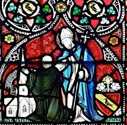 Sneinton Sneinton
St Christopher’s Mission Church
History
Early in the 1880s the vicar of St Stephen’s church, Sneinton, the Rev Canon V. W. Hutton, established a Sunday School for boys on Ashling Street off Meadow Lane, adjoining the Beeston-Nottingham canal on the south-western edge of his parish. This was quickly followed by the opening of a Sunday School for girls on Meadow Lane. At the same time Bible classes for men were provided in a house nearby. These venues quickly became inadequate to meet demand so the vicar organized the building of a mission church on Meadow Lane. Earl Manvers, patron of St Stephen’s and the major landowner in the parish, offered to provide a piece of land on a favourable lease. A corrugated iron building was supplied and erected by Kent & Company of London at a total cost of £400, which was raised by a bank loan. The new mission chapel was designed to accommodate 200 worshippers and was licensed on 24 August 1885, followed by a service of dedication a month later, on 26 September, which was led by the Bishop of Southwell. The sum of £11 12s. 2d. was raised at the ceremony and donated to the cost of the new building. In only nine months the bank loan was repaid. The mission was dedicated to St Christopher.
In early 1886 the vicar of St Stephen’s church, Sneinton, wrote in the church magazine that only 150 could sit and kneel comfortably at St Christopher’s, and explained that the sum of £420 was needed to provide more space. His appeal was successful, and in September 1886 Kent & Company added transepts and lengthened the nave to accommodate a further 170 parishioners.
Whilst housing and building development in the area around the mission was largely completed by 1890, due largely to being somewhat restricted by the canal and River Trent, the population of St Stephen’s parish continued to increase on the eastern side of Sneinton Dale and Colwick Road. As a consequence in 1898 the Nottingham firm of architects, W R and T Booker, were asked to provide plans to remove St Christopher’s mission church to a plot of vacant land on Colwick Road nearer the centre of the district. This plan was not carried out but three years later a new larger corrugated building with parish rooms was erected which opened on the site on 7 September 1901. This building was short lived, being superseded in 1910 by a new brick church (Sneinton St Christopher) on the same site, which cost £800, and the iron church was relocated within the site to become the church hall, where it remained until replaced by a brick building in 1958.
The original mission church on Meadow Lane was finally closed without ceremony some time in 1901-2. It was then used for many years for commercial purposes, before finally being demolished and replaced by new commercial buildings.
The Meadow Lane part of the parish, however, was not abandoned and a small mission hall was opened on the corner of Meadow Lane and Moreland Street in February 1906. The curate in charge of St Christopher’s, the Rev H. Biddell, struggled to raise the necessary funds for building the mission hall and to save money he ‘acted as his own Clerk of Works and more than once had literally taken off his coat and worked on the building.’ The mission hall served its purpose until destroyed by a bomb during an air raid in 1941.
| 




